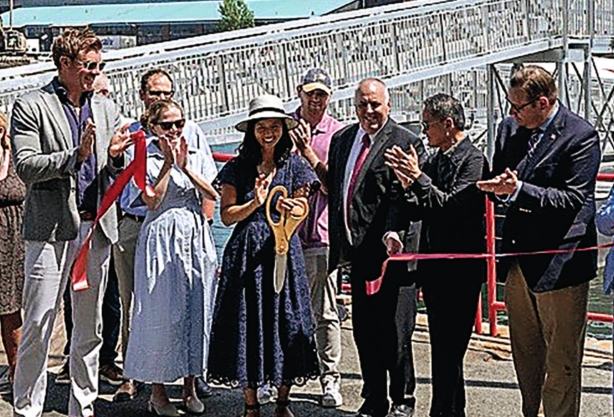
Mayor Wu, City Councilor Ed Flynn and other dignitaries at the ribbon cutting Public infrastructure in the Seaport continues to catch up to the growing local and commuter populations.
The Seaport Transportation Management Association (TMA), in partnership with the City of Boston, has launched a commuter ferry connecting North Station to the South Boston Waterfront. The service is designed to ease congestion by closing a gap in last mile transportation that discourages many Seaport commuters from using public transportation.
The
ferry departs from Lovejoy Wharf at North Station and docks at Pier 10
in the Raymond L. Flynn Marine Park, offering commuters and visitors a
direct, 15-minute ride across Boston Harbor. For those working in the
rapidly developing Marine Park, where office, lab, and industrial uses
are expanding, the ferry marks the most direct connection to and from
North Station.
Patrick
Sullivan, executive director of the Seaport TMA, said the project was
years in the making. The city and the TMA were looking to get ahead of
new zoning that would bring more office jobs to the Marine Park.
“Back
in January of 2020, we convened a group of property owners and
employers that have a presence in the Flynn Marine Park to talk about
some of the access challenges,” Sullivan said. “We had just come off the
success of the Lovejoy Wharf to Fan Pier ferry service, so it was a
pretty obvious choice for those around the table that a ferry would be
the ideal connection to get people from North Station on a one-seat ride
out to the Marine Park.”
The TMA partnered with the Massachusetts Convention Center Authority and the City of Boston to study potential landing sites.
Pier
10, which is owned by the city, emerged as the clear choice, but “The
biggest challenge we faced was the fact that there wasn’t a dock for us
to connect to out in the Marine Park,” Sullivan said.
The TMA raised funds from private donors and member organizations to draft plans for the dock, which they took to the city.
“Ultimately,
the city used dollars from the capital budget to help fund the
construction of the dock, and meanwhile the TMA raised funds from that
group of employers and property owners to fund the actual operating
costs,” Sullivan said.
The
city contributed $2.5 million for the construction of the dock and the
TMA has also received a $400,000 grant from the Massachusetts Department
of Transportation to help cover initial operations. Sullivan said that
the grant covers a third of the first year’s operating costs and will
keep the ferry moving while the service trends toward self-sufficiency.
Operating
costs are covered primarily by TMA member organizations, major
employers and property owners in the Seaport, who wanted to ensure
reliable access for their workforce. Employees of those member companies
can ride the ferry for free, while the general public can purchase
tickets for $5 per trip.
Sullivan
pointed to the success of previous projects to demonstrate the
potential provided by the new ferry. He said that the North Station to
Fan Pier ferry program that began in 2019 helped local businesses
eliminate between eight to ten shuttle buses, and the new ferry is
expected to reduce the need by another four to five.
It’s
harder to measure how many single vehicle commuters transition to
public transit, but such commuters often express frustration with that
last mile connection as a major factor discouraging them from making
their commute with public transit.
The
ferry is open year round, Monday through Friday during the morning and
evening commutes. The TMA is looking into funding that would expand the
hours of operation throughout the day and weekends.